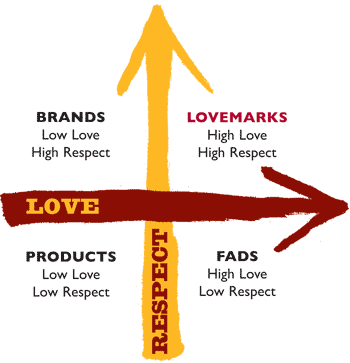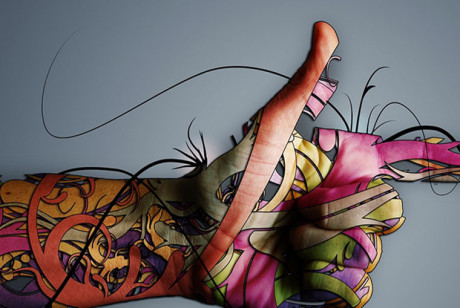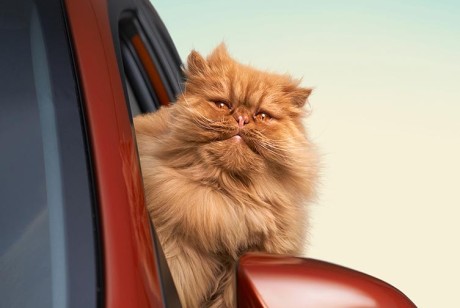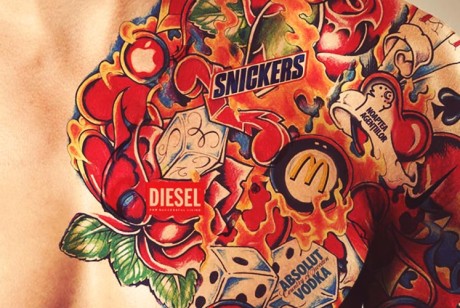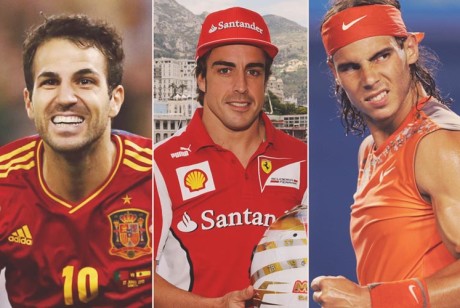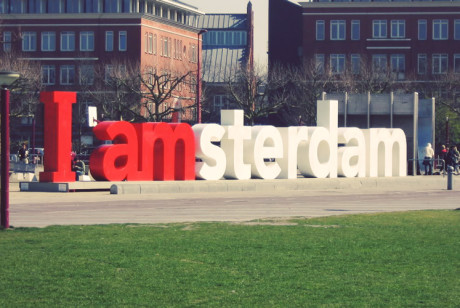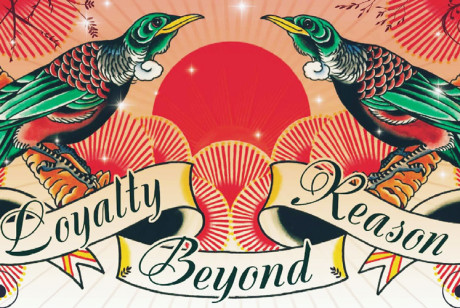Send Lawyers, Guns and Money
Thursday, 28 February 2002 - New York, USA

Presentation Summary
A speech to the International Trademark Association Symposium. Forget Brand-Aid. It’s time for brands to reinvent themselves. Making emotional connections with customers, stepping up to Lovemarks and putting emotion at the centre of relationships. Lovemarks are what great brands must become to retain their value in customer loyalty and premium pricing.
“Send lawyers, guns and money”. If you know the song you’ll know the next line: “The shit has hit the fan”. I guess that’s when you guys are called in. I’ve got to tell you, this is the most lawyers I’ve seen together outside the Enron hearings. Now there’s a bunch of people who are spending a lot of time down-wind of the fan.
When Dick Troll of Harley Davidson asked me to talk to you, he told me my job was to stir things up. When I saw the name of this symposium was “Battle for the brand” I knew that wasn’t going to be a big problem. Don’t kid yourselves. There is no fight to the death between the lawyers and the marketers – the noise is just the gentle coming together of the odd ego or two! And the military language needs to be left back in the 20th century.
A powerful dynamic has been driving business for decades and brands are trapped in its path. A relentless process turning what we truly value into the common-place. It results in the erosion of distinctions. Slashing of premiums. Pressure on innovation. All my clients, all your clients, are wrestling with this same problem in one guise or another. Commodification.
Brands are not exempt. Performance, quality, well-defined benefits don’t cut it any more. Brands have been buffed into blands. They are losing touch with consumers. They are losing power, prestige and value. And the business of marketing is partly to blame. Too many years playing the same tune. An obsession with metrics. Billions spent in the desperate search for customer loyalty, cut-through, new channels. And on protecting difference through the courts – whatever the cost.
The recent race to trademark “Let’s roll!” left me speechless. When people compete to turn heroes into commodities a line has been crossed. Todd Beamer and other passengers on UA 93 were heroes. They were prepared to rush the hijackers on September 11 – and they died with courage. Now some copyright cannibal wants to grab hold of “Let’s roll.” When nothing is sacred there is no mystery. And without mystery you are close, very close, to the end-game. To misery. And very distant from heart-felt human emotion. From joy.
I took on the job of CEO of Saatchi & Saatchi just on five years ago. The mission? To transform it into the hottest ideas shop on the planet.
When I arrived our business was constipated by legal caution. My solution? If legal argument is slowing down the business, get rid of the Legal Department. No in-house lawyers. No legal problems.
And if we want legal problems, we can always hire them in!
Sacrilege? Stupidity? Neither. The energy of success. Like growing our Network revenues faster than the market. Like getting performance-based compensation arrangements with P&G that really work. Like winning first place at Cannes last year for the most creative network globally and the number one Agency office in the world. Saatchi & Saatchi Sao Paolo.
Marketing in the last century has been a journey: from products to trademarks to brands. Each in turn held off furious competition. For a time. Now this journey is coming to an end. Too late for Brand-Aid.
Trademarks are table-stakes. Brands are table-stakes. Useful in the quest for differentiation, vital to survive, but not winning game breakers. The word Brand has become virtually meaningless. Michael Eisner of Disney calls it “over-used, sterile and unimaginative.”
If you signed up for this Symposium you understand something big is happening. My advice? Clutching at brands won’t save you. Reinvent yourselves around ideas like Saatchi & Saatchi have. Burrow deep into the value chain. Don’t obsess over controlling value – help to create it through entire new sectors, products, opportunities. Open up your world. Have some fun.
- You guys are fixed on the rules and the past. Instead join us. “Nothing is impossible” and face the future.
- You’re trapped in a world of “Cage and control.” Our attitude? Use it or lose it.
- You talk rational. We do emotional.
- You’re bound up by tightly-controlled transactions. We thrive on rich relationships.
- You are satisfied with careful stewardship. We relentlessly seek transformation.
- And finally, you believe in brands. We have moved on to Lovemarks.
The world is too big, complex and fast to control. Let it go. There’s a new reality out there. Listen to the voices. Not the inner voices of your own comfort zones. Listen to the voices from outside.
The role of business is to make the world a better place for everyone. Who wants to do anything less? This is a conviction we share with two of our biggest clients. Procter & Gamble and Toyota. Turned out that the right thing was best for business. Where do you stand?
Any successful business now needs to put customers at the centre. To create life-long love affairs with customers or resign itself to the commodity treadmill. The emotional temperature of marketing is hotting up and the emotion is Love.
Love is in the Air
Love is in the air – make no mistake about that. Breathe deep. When I first said the “L” word in public three years ago, everyone squirmed. Now serious business people say Love without blushing. And mean it.
Flick through business magazines, check out the billboards. Love is hot.
The business magazine “Fast Company” picked up on my Love message in 2000. By the next year “Fortune” magazine was asking: “What’s love got to do with it?” And there was Jack Welch with the bug … the love bug.
Now “Fast Company” is back at it again with its February cover story: ‘Love is the Killer App’.
Advertising is loving love too. Even Interbrand gets it: “If people fall out of Love with your brand, you go out of business.”
Chrysler has just launched a new tag-line Drive = Love.
Volkswagen has stamped love on the bug.
Ford have put their heart into it.
What is it with these car guys? I did my “Love Machine” presentation in Los Angeles in February last year. Maybe I should have trademarked the idea! Just kidding.
Saatchi & Saatchi is turned on to Love as our spirit, not as a caption.
We have been evolving Lovemarks for the past three years. Talking, researching, questioning. But we never took out a Trademark. It was an issue in the early years. Advertising agencies are obsessed by “proprietorial tools.” We’ve got them too but Lovemarks were something different. We took a calculated risk and created something we felt was so important we had to give it away. My challenge to Saatchi & Saatchi people: “Use it – or lose it!”
Lovemarks are an idea that can transform not just brands and marketing, but how companies sees themselves and how they feel about their customers. How they can respond to the way people think, not how corporations think.
Lovemarks are the future beyond branding. Darwin would have got it straight off. Monkey to man. Brand to Lovemark. Lovemarks are super-evolved brands.
- Lovemarks are a game-breaking opportunity to reinvent branding.
- Lovemarks connect the company, its people and its brands.
- Lovemarks create the energy of life-time relationships.
- Lovemarks belong to their customers, not to their owners.
- Lovemarks are the ultimate premium profit generator.
Lovemarks are personal. They’re local. Lovemarks stand out from the crowd. They are the charismatic brands that people love and fiercely protect. For keeps. You know them instantly.
- Harley Davidson, definitely. Suzuki? I don’t think so.
- Here’s an iMac; here’s a ThinkPad. Sorry IBM.
- McDonalds is a clear Lovemark. Burger King has got the taste but not the Love.
- New York Firemen. Lovemark. New York Parking warden. Not yet.
- The fabulous Lexus? Got to be. The worthy Lexis? Not even in their dreams.
Saatchi & Saatchi’s challenge to brands started four years ago. Lovemarks evolved from one simple insight: the Love/Respect Axis. A fast, intuitive reality check.
Start with Low Respect and Low Love. Straight commodities like iron, oil, sand. Public utilities like Gas, Water and Drainage. Essential but zero brand heat. A few renegade lawyers probably hide here too.
Move on to Low Respect but High Love. A real mix: from the “we-love-them-but-won’t-admit-it”, to the “too-cool-to-survive” fads. From Bill Clinton to Tommy Hilfiger, Harry Potter to the Furby. Likeable, distinctive, sometimes raffish and unrespectable.
The High Respect but Low Love area is where most major brands fit. This is where a lot of our clients are stuck. This is where most of you belong. Great products, solid R&D, serious customer research. But all fixed on the “e-r” words: newer, brighter, stronger, bolder. And all uncomfortably close to the commodification trap.
Now turn to the uncharted territory: the Love dimension of the Love / Respect axis. Here the breakthroughs are. Here we can make deep connections with customers.
Lovemarks are inclusive. They want it all. Forget “either/or”. It’s “and/and”. Love and respect. Heart and mind. Emotion and reason. Local and global. And, and, and.
Time to put the “and” back into brand.
Toyota gets it. We’ve been working with them on Lovemarks for two years now. The mind-set in Toyota has changed. Car guys always ask each other “How much metal did you move?” We changed the question: “How much does the metal move you?”
Senior Vice President at Toyota USA Don Esmond crystalised the new Toyota challenge: “It’s time to move from the most respected car company in America to the most loved.”
Brands can only evolve into Lovemarks when they include Mystery, Sensuality and Intimacy. The fire of human relationships – banished from Harvard Law.
Mystery to draw together the stories, metaphors and icons that give a relationship its texture. Complexity, layers, revelations, intuition, humour and excitement.
Sensuality as a portal to the emotions. Vision, sound, hearing, touch, taste. This is how we experience the world.
And the warm breath of Intimacy. Empathy and inspiration lit up with passion. The intimate connections that are more important than ever.
Over the past two years Saatchi & Saatchi have identified the fourteen elements that make up a Lovemark. We created an intuitive idea and insight generator we call a Lovemarker.
We have tested our Lovemarker with Fortune 100 companies and their brands, cars, cities and countries, universities, people. The result? Fresh insights for instant improvements. Unexpected new horizons. A twist in the tail of the familiar.
With selected elements from the Lovemarker let’s check out Disney’s profile. A world-famous brand. A highly successful corporation. The holder of vast intellectual property.
Mystery
First mystery. Stories are the nervous system of Lovemarks. Disney has always understood stories and tapped into them with nothing short of genius. Stories from different times and places all infused with the Disney magic. Snow White, Mulan, Sleeping Beauty. The pantheon is remarkable. But new competitors are pushing in appealing fresh directions: Shrek and Lord of the Rings versus the Lion King. Tough call.
Walt Disney was the master of tying the past, present and future together. Frontierland, Adventureland, Futureland. In 1955 Disney’s commitment was engraved on a plaque just inside the gates of Disneyland: “Disneyland is dedicated to the ideals and dreams that have created America…”
This simple commitment has blurred. How? Expansion to other continents. Accommodation of different cultures. Demands for diversity. Intense competition. Less focus on America’s unique values so Disney can fit better with other places and cultures.
Disney is poised at an amber light. The inspiring vision of Walt Disney has paled. Without the aura of Walt, is Disney anything more than another smart entertainment corporation? A crucial quality of a Lovemark is that people feel they own it. But Disney battles that emotion every day. They have always been at their most corporate in the fierce protection of their Icons. We all know stories of Disney forbidding the use of its characters by schools and communities. This is not the action of a Lovemark.
The great Disney icon is Mickey Mouse. Disney himself said: “If you can dream it, you can do it. Remember that this whole thing was started with a mouse.” The passion for Mickey is still intense after 74 years. The web site www.hiddenmickeys.org records every time a rogue Imagineer includes a sly image of the Mouse into a movie, a ride, a book … anything. True love? Sure – but kind of creepy!
Businesses face a big issue this decade: if they defend their trademarks to the death, they lose the chance of becoming a Lovemark. If they miss out on being a Lovemark they risk slipping down to commodity status. It’s a no-brainer. The Lovemark route is more secure – and more fun.
Sensuality
When it comes to the five senses Disney is text-book perfect. Great songs, great visuals, great experiences that have kept them on top for decades.
But “Perfect ” can also be an alarm bell. As the competition increases, distinctive personality and character matter more. That was Walt Disney’s gift. His creations were like his children – and we could feel it. Today the expertise and dedication of his successors is extraordinary, but their emotion is more professional pride than delight in how it makes us – their customers – feel.
Take Mickey. It’s hard to remember the cheeky Mickey of the early days. He feels all of 74 years old. Over time he’s been scrubbed and worn so our senses slide over him. Who can tell the touch of Mickey? What’s left of the mystery?
Not only has Disney stereotyped its sensual repertoire, there are others out there connecting more intensely with consumers and raising their expectations. Take Apple. Steve Jobs aimed to make people want to lick the new Mac Operating System “Aqua”. A computer interface as a full sensuous experience! Breakthrough thinking.
Intimacy
Along with Mystery and Sensuality, Intimacy breathes life into a Lovemark. The deep emotion and empathy that comes from true love.
The Disney family was once effortlessly empathetic. They were welcome in every home. But today the trappings of corporate control and the effort to please everyone are taking their toll.
It goes deep. Surprisingly the Mouse is not the top earner for Disney. That honor goes to Pooh Bear with an estimated one-fifth of the $25 billion Disney generated in 2001. I’ve always felt that Disney had a business relationship with the bear. He was a piece of property purchased only five years before Walt Disney’s death in 1961. Never quite a real member of the family. Contrast this with their intimacy with Mickey Mouse. They loved the Mouse, the bear they just put out to work. Now Disney is battling in the courts with A A Milne’s descendants. That’s the property business for you.
Paul Pressler, Chair of Walt Disney Parks and Resorts shared with me his ten traits of a great brand. When put beside a Lovemarker the challenge for Disney is clear. They separate thinking and feeling. This can drift close to manipulation. They put the goals for their business on the same level as their customers. Emotional rewards above emotional relationships. And underplay the rich sensuality of what they offer.
My summary. Disney is still a Lovemark but they need to focus on the stuff that makes a difference to people. Bring some flowers home. Give the kids a hug. Do what you’ve always done best by surprising and delighting us from the heart.
Peak Performance
Lovemarks are about transforming brands. But we need more. Enter Peak Performance. Lovemarks is the destination great brands must aspire to. Peak Performance is the process for getting there. How to transform organisations with vision and inspiration.
The missing link in brand thinking has been the “how.” How do we get our organisations to live the brand? How do we create extraordinary customer experiences every time?
Bottom-line, we cannot do it through control, process flows and structure. That route will give us an illusion of control that will be short-lived, hard-won and ultimately disappointing.
Time for a new plan. I worked with a couple of academic colleagues on three very practical questions that go to the heart of long-term organisational success:
- How do you ensure your people care passionately about what they do?
- How do you keep getting better when you are already the best?
- How do you respond to extreme pressure?
We found the answers where there is no place to hide. The tough world of elite professional sport. The story is told in our book “Peak Performance” but for today some high points.
Forget management and doing things right. Ignore leadership and doing the right things. In this new millennium these are just more table-stakes.
What makes a difference now is inspiration and spirit. The qualities that make an organisation special. Loved. All the emotion and passion twentieth century business got rid of. All the stuff we need to bring back to the centre.
People without passion or emotion never became great lawyers, great marketers, great anything. This is the conviction that drives Peak Performance. At its centre is the Inspirational Dream.
The Inspirational Dream moves people so they want to belong. It’s not made to be measured. It’s about reaching for the stars, not counting them. At Saatchi & Saatchi our Inspirational Dream that we will be revered as the hothouse for world-changing creative ideas that transform our clients’ businesses, brands and reputations.
The Inspirational Dream is given shape in the Greatest Imaginable Challenge. A goal that is a clear ambition, not a fuzzy fantasy. A measurable goal defined by dollars or share or competitive positioning.
To be a Peak Performing organisation you must have Focus. Committed, shared Focus. It may look obsessive to outsiders, but insiders value it above all else. At Saatchi & Saatchi our focus is “To create and perpetuate Lovemarks through the power of our ideas.”
And finally in this summary list is the indispensable element in every Peak Performing Organisation. The person at its centre: the Inspirational Player. And here Peak Performance takes off.
Over the past four years we have been transforming Saatchi & Saatchi from an advertising agency into an Ideas Company. From a collection of offices around the world into a Peak Performing Organisation. The transformation of our people from effective leaders into passionate inspirers. Our clients from brand leaders into Lovemarks. Our core belief “Nothing is Impossible”.
Other companies aspire to Peak Performance too. Companies with very different businesses, very different cultures, but the same drive and passion.
Take Procter & Gamble. Disciplined. Process-driven. The inventors of brands. The masters of metrics. We’ve been working with them on PPO for the last couple of years. The Chief Executive A G Lafley understood that for his people to live the brand and to aspire to a Lovemark, they had to perform at peak. To step up to Inspiration.
Every quarter AG and I lead a two-day workshop for 20 top Inspirational Players in P&G. It’s a big commitment but the impact is immediate. The unleashing of key Peak Performers to be the best they can be.
What This Means to You
I want to end with an action list. Four ideas you can get started on right now as you reinvent yourself as living, breathing, loving Ideas People.
- Ease up on the controls. Expertise and professional language are valuable, but they also fence you in. While you’re stopping the forces of evil breaking down the door, you can’t get out of the house.
- Step up to emotion. Feel it, don’t just analyse it. Scary? Sure, but it’s the quickest way to go from a cubicle notwork into a relationship network. Humans are powered by emotion, not by reason.
- Learn from women. So you don’t think they have anything to tell you? This is the first event I’ve been to in years with no women speakers. Red light guys.
- Get intimate with Lovemarks. Check out my web sites saatchikevin.com and Lovemarks.com. Join the discussion, learn to live with love.
